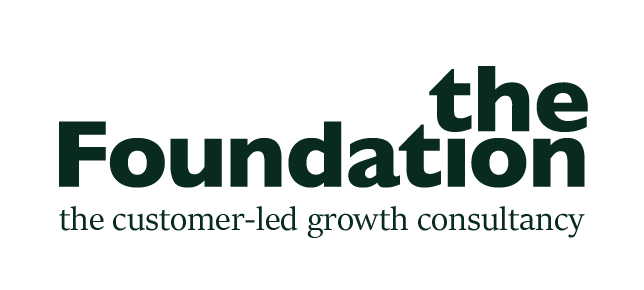Immersive Insight: Moving from Data to Action
Do you trust your data enough to make decisions? At The Foundation, we believe customer insight should be more than numbers on a page or charts in a deck - it should spark belief, create empathy, and drive real change.
Yet too often, research remains underused. According to Accenture, only a third of businesses trust their research enough to act on it, and just 27% say their insights produce truly actionable recommendations. This ‘data value gap’ is growing, leaving organisations awash in information but starved of impact.
So how do we turn insight into action?
From Information to Impact
By definition, an insight should drive action. It’s the engine behind evidence-based decision-making. But insights don’t always land - they’re too weak, too convenient, or too disconnected from lived customer reality.
The most powerful insights are those that are true, new, and revealing - ones that shift assumptions and open up possibilities. They’re not just lying around waiting to be discovered. They require effort to dig beneath the surface to uncover the hidden motivations, frustrations, and desires of customers.
Why Belief Matters
Fancy decks and big datasets aren’t enough. For leaders to act, they must believe - not just that customers feel a certain way, but that acting on those needs will create value. And belief is rarely born from knowledge alone. It comes from feeling something.
That’s where empathy enters the picture. True customer-led organisations don’t just understand their customers; they connect with them. They practice compassionate empathy, the kind that not only shares a customer’s feelings but moves people to act.
Why It Works
Immersive insight isn’t just a clever way of presenting research — it works because it taps into how human beings are wired to learn, empathise, and act. Psychology offers several reasons why these approaches are so powerful:
1. Presence reduces psychological distance
When people are placed in immersive settings — whether through VR, vivid narrative, or lived experience — they report a heightened sense of presence. This reduces psychological distance: instead of customers being ‘out there’, they feel immediate and close. That closeness drives empathy and shifts decision-makers from abstract thinking to human connection. One study found that greater immersion increased both empathy and the likelihood of taking action afterwards (Shin, 2023).
2. Stories are stickier than stats
Neurological research tells us that emotion helps encode memory. Dry numbers fade, but stories with human detail stay with us. Immersive methods turn insights into stories you can see, hear, and feel. When people are emotionally engaged, they remember more, believe more, and are far more likely to act. Vogel et al. (2021) found immersive storytelling boosted both affective and cognitive empathy, making the message ‘stick’ far beyond exposure.
3. Simulation and mirror neurons
We don’t just hear about others’ experiences - our brains try to simulate them. Mirror neuron research suggests that when we observe someone’s actions or emotions, our own neural circuits fire as if we were experiencing them ourselves. Immersive methods amplify this effect: leaders cooking alongside families, for example, aren’t just observing, they’re physically simulating the customer experience, which makes the learning deeper and harder to ignore.
4. Compassionate empathy moves us to act
Psychologists distinguish between cognitive empathy (understanding), emotional empathy (feeling), and compassionate empathy (the desire to help). Immersive insight is designed to get people beyond sympathy or detached understanding and into compassion. It doesn’t stop at awareness; it compels action. That’s why teams leave immersion experiences not just informed, but energised to make change happen.
5. Social proof and shared experience
Finally, immersive insight works because it is often shared in groups. When leaders or teams go through the experience together, they don’t just see customers differently, they see each other differently. The social reinforcement creates a collective belief that acting for customers isn’t risky or fringe, but normal and necessary. This accelerates cultural change inside organisations.
In short: immersive insight works because it harnesses the psychology of empathy, memory, simulation, compassion, and social proof. It shifts customer insight from abstract knowledge into lived, emotional reality, and that is what sparks belief and drives action.
The Power of Immersive Insight
Within The Foundation, we call this approach Immersive Insight: experiences that reconnect leaders and teams with real customers, shifting beliefs and sparking the energy to act in customer-led ways.
Immersive Insight isn’t another research ‘sheep dip’. It’s about creating experiences that bring customers to life in vivid, human terms. Whether that’s:
Total immersion in real lives – like helping a leadership team cook meals from scratch to understand the complexity of family life.
One-to-one connections – such as a fashion editor realising not every reader could afford her wardrobe.
Extended engagement – like a senior leader at a financial services brand grasping why pensions aren’t meaningful to everyone.
Real-time experiences – for example, a COO learning first-hand that call-out times weren’t acceptable, despite regulator benchmarks.
Co-creation alongside customers – recognising the gap between what people say they want and what they actually buy.
These moments transform abstract ‘customer data’ into visceral experiences that shift perspectives and unlock change.
Becoming a Customer Pioneer
At The Foundation, we help organisations move beyond information overload to clarity and action. Through Immersive Insight, we create experiences that don’t just deliver findings, they shift beliefs, inspire empathy, and empower teams to lead with customers at the heart.
Because being customer-led isn’t about knowing more. It’s about feeling more - and doing more.
